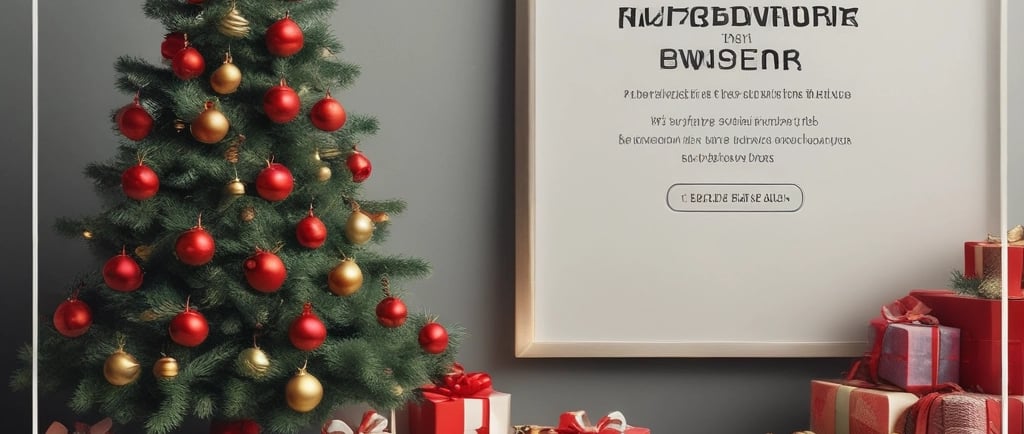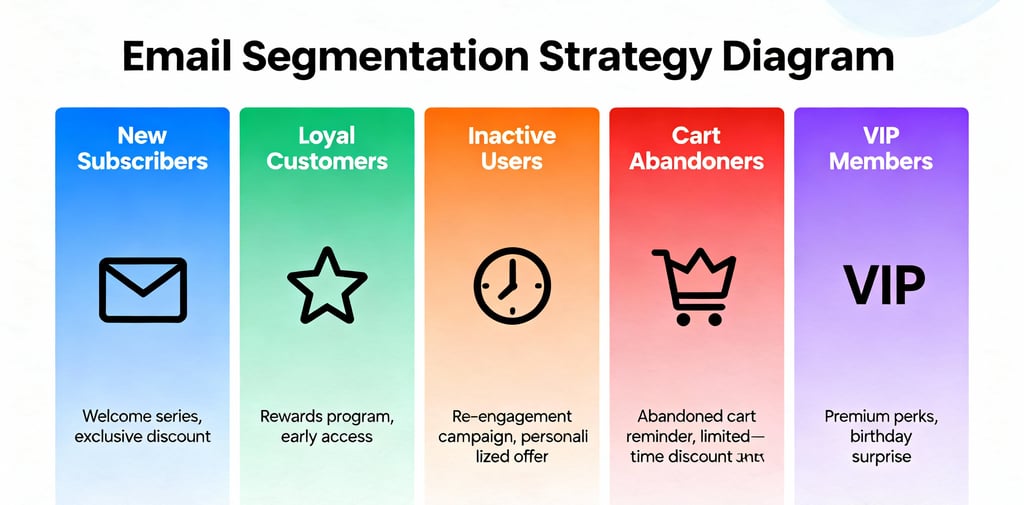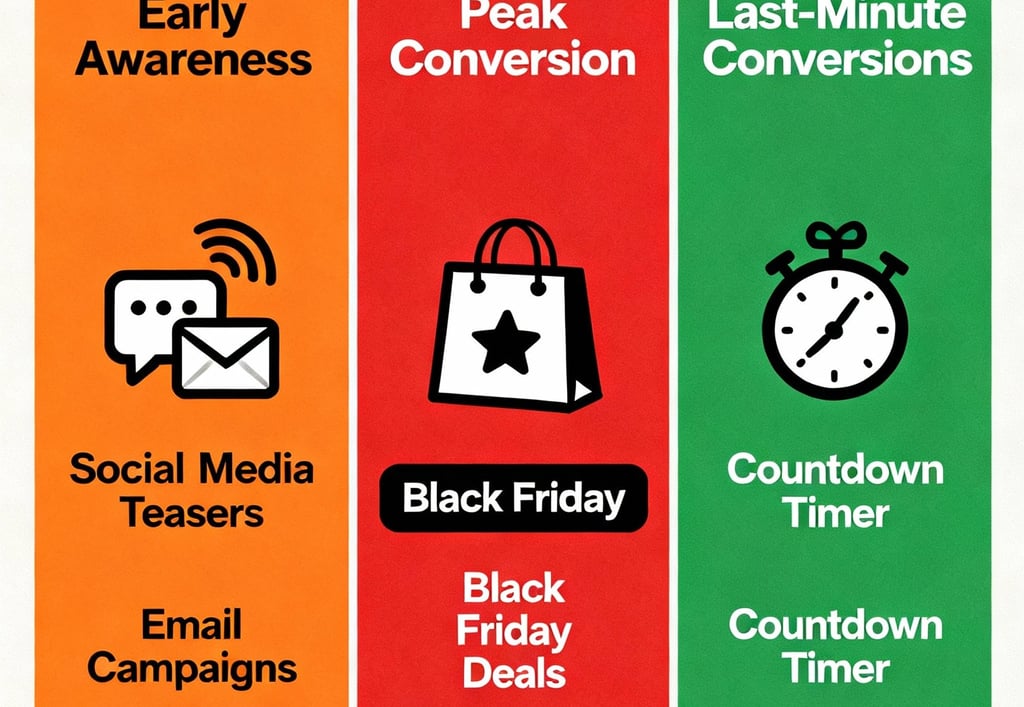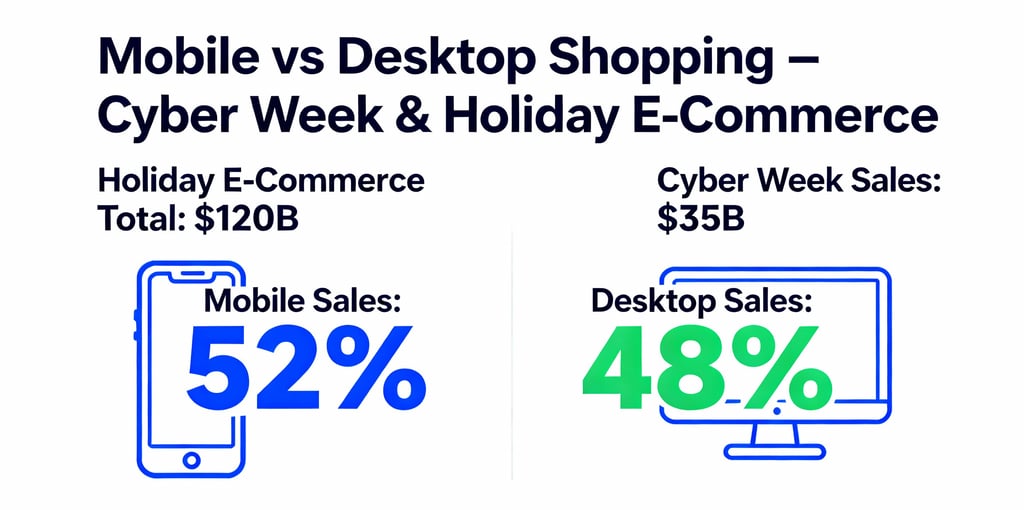
Master Year-End Holiday Marketing Strategies 2025
Elevate your year-end holiday marketing campaign with proven strategies and statistics. Discover effective marketing tactics for a successful multi-channel approach from October to December 2025.
Rudra Prakash Parida
11/11/2025


Quick Overview
The holiday season represents a critical revenue opportunity for businesses, with some brands generating up to 26% of their annual revenue during November and December. However, succeeding during this period requires more than last-minute promotions it demands a strategic, multi-phase year-end holiday marketing campaign that aligns with evolving consumer behaviour. This comprehensive guide outlines proven strategies to help you build a results-driven holiday campaign that captures early shoppers in October, maximises the Black Friday/Cyber Monday surge in November, and converts last-minute buyers in December.
Understanding the 2025 Holiday Shopping Landscape
The 2025 holiday shopping season is unfolding against a backdrop of economic complexity. While consumers remain committed to holiday spending, their behaviour reflects newfound caution. According to PwC's 2025 Holiday Outlook, consumers expect average holiday spending of approximately $1,552 per person, down 5% from 2024 marking the first notable drop since 2020. However, this doesn't signal a retail apocalypse; rather, it reflects a fundamental shift in how shoppers approach their purchasing decisions.
Today's holiday consumers are deliberately deciding where to allocate their budgets. Gift spending has declined 11% year-over-year to an average of $721, while travel and entertainment spending remain relatively stable. What's most important for holiday marketing strategy is understanding that value-seeking behaviour now dominates the landscape: 77% of shoppers expect higher prices on holiday goods, while 84% say they expect to cut back on general spending over the next six months. This creates both a challenge and an opportunity for brands willing to meet consumers with precision rather than generic discounts.
The UK market presents particularly compelling opportunities. Adobe forecasts record online spending of £26.9 billion during the 2025 UK holiday season (November 1–December 31), representing a 4.2% year-on-year increase. Black Friday is expected to drive the highest single-day spending at £1.19 billion, underscoring the importance of strategic preparation well in advance.
The Multi-Phase Approach to Year-End Holiday Marketing
Rather than treating the entire holiday season as one monolithic campaign, successful holiday marketing campaigns adopt a three-phase approach that aligns with distinct consumer behaviours and shopping timelines.
Phase 1: Early Awareness (October–Early November)
The first phase of your holiday marketing campaign targets early shoppers who begin researching and planning purchases in October. According to Circana's research, seasonal shopping timelines are shifting earlier than traditional patterns, with more consumers beginning their holiday research in September and October.
Key tactics for Phase 1:
Build anticipation with teaser content and behind-the-scenes stories
Engage early planners with sneak peeks and early-bird specials
Educational content that helps customers plan their holiday purchases
Email warm-up campaigns introducing upcoming holiday promotions
Influencer seeding with micro-influencers to build early awareness
During this phase, focus on brand awareness keywords like "holiday gift ideas," "early holiday shopping," and "gift guides 2025." Your content should educate readers on planning ahead while subtly positioning your brand as the go-to resource for holiday solutions.
Why October matters: According to data from Absolute Digital, starting your Christmas marketing campaign in October allows you to refine strategies based on early consumer response, ensuring a more targeted and effective approach as peak season approaches.
Phase 2: Peak Conversion (Mid-November–Cyber Monday)
The second phase coincides with Black Friday and Cyber Monday events that drive unprecedented email volume and shopping activity. Black Friday alone saw 116.5 million emails sent in 2024, surpassing Cyber Monday's 106 million. These events represent the highest-engagement periods of the year, with Black Friday emails achieving the highest open and click-through rates.
This is where your omni-channel holiday marketing strategy becomes critical. Consumers are researching online (58% of shoppers prefer online gift discovery), visiting stores, comparing prices, and checking social media simultaneously. The brands that win are those present across all touchpoints with consistent messaging.
Peak-phase strategies:
Limited-time offers that create urgency (flash sales, BOGO deals)
Personalised product recommendations based on browsing history
SMS and push notification sequences for time-sensitive deals
Mobile-optimised everything (52% of Cyber Week 2023 sales occurred on mobile)
Social media takeovers and influencer-led promotions
User-generated content campaigns showcasing real customers
The statistics around email performance during this period are compelling. Personalised subject lines increase open rates by 26%, while segmented campaigns can boost revenue by up to 760%. Emails sent between 7:00 AM and 12:00 PM achieve better engagement, and automated emails generate 320% more revenue than non-automated campaigns.
Phase 3: Last-Minute Conversions (December 1–December 24)
The final phase targets last-minute shoppers racing against shipping deadlines and holiday events. This segment represents a significant portion of holiday sales, requiring urgency-focused messaging and fast fulfillment guarantees.
December campaign characteristics:
Countdown messaging emphasising shipping cutoff dates
Last-minute gift guides organised by recipient and budget
Fast-shipping guarantees and same-day delivery options
Gift card promotions for ultimate convenience
Retargeting campaigns to recover abandoned carts
Limited inventory callouts to create scarcity
Building Your Omnichannel Holiday Marketing Strategy
One of the most significant shifts in holiday marketing trends for 2025 is the complete normalization of omnichannel shopping. According to the Holiday Consumer Shopping Report 2025, 61% of holiday shoppers prefer to discover gifts in-store, while 58% look online but these aren't mutually exclusive groups. Most consumers now move fluidly between channels, researching online before purchasing in-store and vice versa.
The omni-channel reality: 52% of shoppers research online before making in-store purchases, while 64% of UK shoppers prefer online holiday shopping. This means your year-end holiday marketing campaign must deliver a seamless experience across every touchpoint.
Implementing Omnichannel Personalization
Hyper-personalized offers replace the generic "20% off everything" approach. True personalisation means sending a 20% off coupon for the specific product a customer viewed three times, abandoned in their cart, and which is available at their local store.
Omnichannel personalisation tactics:
Dynamic product recommendations based on real-time and historical data
Location-based messaging targeting customers near physical stores
Cross-channel consistency in branding, tone, and offers
Synchronised inventory showing product availability across channels
Unified customer profiles that track interactions across touchpoints
The results speak for themselves. Arezzo, Latin America's largest women's footwear brand, implemented a hyper-personalised omni-channel strategy using customer data, browsing behavior, and purchase patterns. The outcome: a 44% increase in Black Friday order volume and 28% revenue growth year-over-year.
Mobile-First Holiday Marketing
Mobile dominance cannot be overstated. With over half of Cyber Week sales occurring on mobile devices, a mobile-first holiday marketing strategy isn't optional, it's essential. Your entire campaign, from emails to push notifications to website design, must be optimized for smartphone users.
Mobile optimisation priorities:
Responsive email design (41.6% of email opens occur on mobile)
App-exclusive offers to drive downloads and engagement
Push notification sequences for high-visibility promotions
One-click checkout processes
Mobile wallet integration for Apple Pay and Google Wallet
Fast-loading product pages (critical for conversion)
Push notifications deserve special attention. When used strategically, they deliver higher open rates than email and SMS, making them ideal for flash sales and time-sensitive Black Friday offers. The key is balancing promotional pushes with non-transactional content that keeps your brand top-of-mind without overwhelming users.
Email Segmentation and Personalisation: The Revenue Multiplier
Holiday email marketing remains one of the highest-ROI channels available, with email delivering a $36 return for every $1 spent. However, generic email blasts have become ineffective. Segmentation and personalisation are now table stakes.
Advanced Email Segmentation Strategies
Rather than segmenting solely by demographics, implement these sophisticated approaches:
Behaviour-based segmentation:
Purchase history during previous holidays (send product complements to buyers of holiday décor)
Browsing patterns (gift hunters vs. self-purchasers)
Cart abandonment status (recovery campaigns)
Email engagement level (VIP re-engagement vs. cold segments)
Intent-based segmentation:
Holiday-specific interests (holiday recipes vs. gift ideas)
Delivery deadline urgency (same-day vs. slow shipping preferences)
Product category preference (electronics, apparel, experiences)
Budget tier (luxury, mid-range, value)
Lifecycle segmentation:
New subscribers (introductory holiday offers)
Long-time customers (exclusive loyalty rewards and early access)
Inactive subscribers (reactivation campaigns with special incentives)
The impact of segmentation is dramatic. Segmented campaigns can increase revenue by up to 760%, and when combined with personalized subject lines and dynamic content, they transform email from a broadcast channel into a personalized shopping assistant.
Email Automation for Holiday Campaigns
Automated email campaigns generate 320% more revenue than one-off sends. A sophisticated holiday email automation sequence might include:
Welcome series (introducing holiday offers and capturing preferences)
Browse abandonment (reminding users of viewed products)
Cart abandonment (recovering nearly 10-15% of lost orders)
Post-purchase (upsells, cross-sells, loyalty rewards)
Re-engagement (win-back campaigns for inactive subscribers)
Post-holiday (feedback requests, January sales previews)
Harnessing AI and Personalisation Technology
Artificial intelligence is fundamentally transforming how brands execute holiday marketing strategies in 2025. AI-powered tools aren't futuristic—they're essential for competing at scale.
AI-Driven Applications in Holiday Marketing
Agentic AI represents the frontier of AI application in retail. Unlike traditional chatbots that answer questions transactionally, AI agents proactively anticipate customer needs, compare prices, apply coupons, and even complete purchases on behalf of shoppers. Early data shows that 43% of Gen Z shoppers are turning to AI for holiday shopping inspiration.
Real-world impact: Klarna implemented an AI assistant that handled two-thirds of its customer service chats the equivalent work of 700 full-time agents while maintaining satisfaction scores and resolving issues faster and more accurately.
Specific AI applications for your holiday marketing campaign:
AI-Powered Personalisation:
Predictive product recommendations based on browsing and purchase patterns
Dynamic pricing optimised by demand and inventory
Real-time segmentation that evolves with customer behaviour
Sentiment analysis of reviews and customer feedback to inform strategy adjustments
AI-Enhanced Customer Service:
Chatbots for common holiday questions (shipping, returns, gift recommendations)
Intelligent routing of complex issues to human agents
24/7 availability during peak holiday demand periods
User-Generated Content: Building Authentic Holiday Connections
In an era of ad saturation, user-generated content (UGC) has become a trust multiplier. 92% of consumers trust recommendations from friends and family above all other advertising, and 70% of Gen Z and 78% of millennials find UGC helpful with purchasing decisions.
Strategic UGC Integration
Rather than treating UGC as optional, integrate it into every phase of your year-end holiday marketing campaign:
UGC collection strategies:
Branded hashtag campaigns encouraging customers to share holiday moments with your products
Photo contests with rewards for best submissions
Review incentives for detailed product feedback
Influencer-curated gift guides featuring your products
Behind-the-scenes content showcasing how your team celebrates
UGC deployment channels:
Website product pages (customer reviews and photos increase trust)
Email campaigns (user testimonials and photos outperform branded content)
Social media (UGC engagement rates are 28% higher than branded content)
Paid advertising (ads featuring real customers garner 73% more positive comments)
The authenticity factor cannot be overstated. 84% of Gen Z tend to trust brands that feature real customers in their ads. This single statistic justifies the investment in robust UGC programs.
Social Media and Influencer Strategy for Holiday Success
Social media has become a primary discovery channel for holiday shopping. 43% of holiday shoppers typically start with research on search engines, while 39% begin on brand and retailer sites. However, 61% prefer in-store discovery and 58% prefer online with social media being the connective tissue.
Influencer-Driven Holiday Campaigns
Rather than celebrity endorsements, micro-influencer strategies deliver superior ROI. Micro-influencers (10K–100K followers) have more engaged audiences, higher trust levels, and are often willing to partner for product exchanges or modest fees.
High-performing influencer tactics:
Gifted-Based Gift Guides: Partner with lifestyle influencers to curate "Top 10 Gifts for ___" content featuring your products. L'Occitane's Black Friday campaign used influencer gift guides that moved the needle more than flashy discounts elevating brand perception and increasing buyer confidence.
Advent Calendar Series: Create a "12 Days of Holiday" campaign where influencers reveal daily deals or product spotlights. Alo Yoga's 2024 advent calendar campaign, amplified by wellness influencers, generated massive social buzz, sold out rapidly, and delivered millions of views and record engagement.
Holiday Countdown Content: Build anticipation with sequential content counting down to Black Friday or Christmas, with daily tips, recipes, or product features.
UGC Contests: Encourage followers to create content using your products, then feature the best submissions on your brand channels.
Creating Urgency Without Alienating Customers
The challenge of holiday marketing strategy lies in creating urgency without triggering decision fatigue. Today's consumers receive constant promotional messages; the winners are brands that create perceived scarcity without feeling manipulative.
Urgency Tactics That Convert
Time-Based Urgency:
Flash sales lasting 4–12 hours create immediate action
Countdown timers on product pages showing offer expiration
Shipping cutoff reminders tied to specific dates
Limited-quantity callouts showing remaining inventory
Exclusivity-Based Urgency:
Early access for email subscribers or loyalty members
Members-only pricing for loyalty program participants
Bundle deals available only during specific windows
Exclusive products limited to the holiday season
The most effective approach combines these elements with genuine value not just artificial scarcity. A shipping cutoff reminder combined with free shipping creates real urgency based on actual constraints, whereas a "Sale ends at midnight!" message with arbitrary timing feels manipulative.
Measuring Success: Key Holiday Marketing Metrics
An effective holiday marketing campaign requires robust measurement. Beyond revenue, track these critical metrics:
Email Campaign Metrics:
Open rates (industry average: 15–25% for holiday campaigns)
Click-through rates (industry average: 2–4%)
Conversion rates (track by segment and campaign phase)
Revenue per email and ROI
Overall Campaign Metrics:
Year-over-year sales growth during Nov–Dec
Average order value (AOV) by channel
Customer acquisition cost (CAC) for new holiday shoppers
Customer lifetime value (CLV) of holiday-acquired customers
Channel attribution (which channels drive conversions)
Customer Experience Metrics:
Cart abandonment rate (target: <70%)
Customer satisfaction (CSAT and NPS during holidays)
Returns rate (quality of holiday sales)
Email unsubscribe rate (caution: sign of over-messaging)
Practical Implementation Timeline: Your Holiday Marketing Roadmap
Success requires disciplined execution across a compressed timeframe.
August–September: Strategy & Planning
Audit last year's performance
Define goals (revenue targets, customer acquisition, AOV)
Develop campaign calendar
Identify influencer partners
Plan email sequences
October: Campaign Launch
Release early-bird offers
Seed influencer content
Begin email nurture campaigns
Optimise website for mobile
Set up analytics tracking
November: Peak Execution
Deploy Black Friday/Cyber Monday campaigns
Maximise email, SMS, and push notification sends
Activate all influencer partnerships
Monitor performance hourly (not daily)
Be ready to adjust based on real-time data
December: Last-Mile Conversions
Focus on shipping cutoff messaging
Deploy final wave of campaigns
Highlight last-minute gift options
Maintain customer service excellence
Prepare post-holiday engagement
Real-World Case Study: Multi-Brand Success
Arezzo, Latin America's largest women's footwear brand, illustrates the power of strategic omni-channel holiday marketing. Working with SAP Emarsys, Arezzo implemented a coordinated strategy across three brands in just over one month, using:
Fast Abandoned Cart automation
Top Category Cross-Sell recommendations
Hot Leads Conversion strategies
Personalized communications by lifecycle stage
Multi-channel sends (email, SMS, web)
Results:
44% increase in Black Friday order volume
28% year-over-year revenue growth
Significantly improved customer engagement across all three brands
This demonstrates that sophisticated holiday marketing isn't limited to massive corporations strategic execution can yield outsized returns regardless of company size.
FAQ: Common Holiday Marketing Questions Answered
Q: When should I start planning my holiday marketing campaign?
A: Begin planning in August for October launch timing. Early September is the latest for executing a full three-phase campaign. Q3 planning ensures you're not rushing critical decisions during peak season.
Q: How much should I increase email send frequency during holidays?
A: Research shows that 65.9% of consumers are happy to receive holiday marketing emails, but frequency matters. Generally, increase from weekly to 2–3 times weekly during November–early December, then back off unless you have specific flash sales. Monitor unsubscribe rates closely; if they spike, reduce frequency.
Q: Should I focus on discounting or differentiation?
A: Both matter, but differentiation through personalization, customer service, and unique positioning often outperforms pure discounting. Consumers are skeptical of artificial markups followed by discounts. Focus on genuine value whether that's through discounts, exclusive products, exceptional service, or authentic storytelling.
Q: What's the optimal send time for holiday emails?
A: Emails sent between 7:00 AM and 12:00 PM generate the best open and click rates, aligning with morning routines and work startup. However, segment by time zone and test within your own audience some segments may perform better at different times.
Q: How do I avoid overwhelming customers with messages?
A: Use preference centers letting customers choose email frequency and content type. Segment your list so inactive customers receive fewer messages than engaged buyers. Monitor unsubscribe and complaint rates as leading indicators of fatigue. Balance promotional content with valuable, non-sales messaging (tips, stories, entertainment).
Q: Is mobile optimisation really necessary?
A: Absolutely. With 52%+ of online sales occurring on mobile during Cyber Week, mobile-first isn't optional. Any email, landing page, or website that isn't optimised for mobile is leaving revenue on the table.
Q: Should I use influencers or just run ads?
A: Both. Influencers build authenticity and reach engaged audiences, while paid ads scale reach. Micro-influencers often deliver better ROI than big celebrities. Consider a balanced approach: 40% influencer, 40% paid, 20% organic.
Q: What should I do if sales are lagging mid-campaign?
A: Review these elements immediately: Are your emails reaching inboxes (check spam folder)? Are landing pages mobile-optimised? Are offers genuinely competitive? Have you tested different creative approaches? Real-time data is your friend adjust messaging, targeting, or offers based on what's (or isn't) working.
Conclusion: Building a Holiday Marketing Campaign That Converts
The year-end holiday marketing campaign landscape in 2025 demands sophistication, agility, and customer empathy. Success isn't about the biggest discounts or loudest ads it's about meeting customers precisely where they are with the right message, at the right time, across the right channel.
The brands that win this holiday season will be those that:
Start planning early (by October at the latest)
Embrace personalisation at scale using data and AI
Meet customers omni-channel (seamless online-to-offline)
Build authentic connections through UGC and influencers
Measure relentlessly and adjust based on real-time performance
Treat customer experience as a differentiator (not just transactional)
The potential is enormous £26.9 billion in UK online spending alone this season—but capturing your share requires disciplined strategy execution. Begin with the three-phase approach outlined here, layer in the personalisation and omni-channel tactics discussed, and commit to measurement and optimisation throughout.
Your 2025 holiday marketing campaign begins today. The brands that treat November and December as a strategic marathon, not a sprint, will be the ones reporting record revenue and accelerated customer loyalty into 2026.






Contact
Reach out for insights and support
Phone
+447768010239
© 2025. All rights reserved.